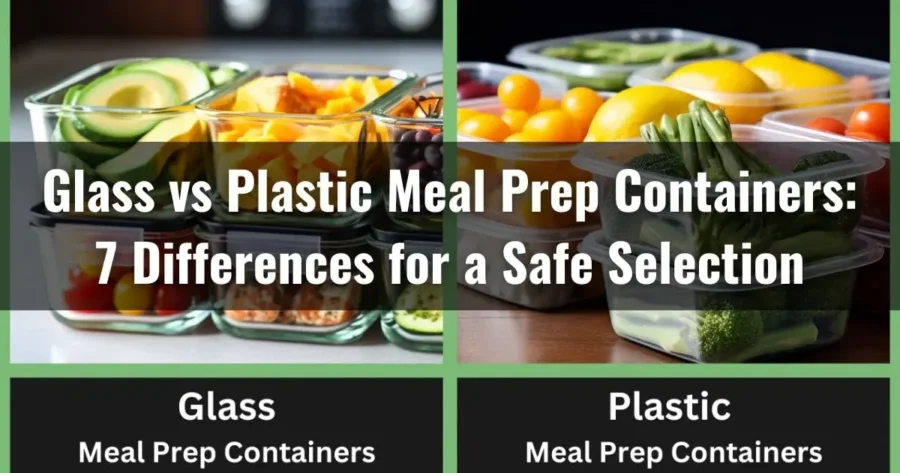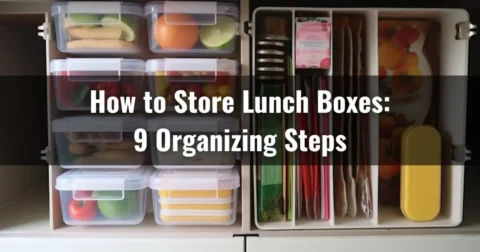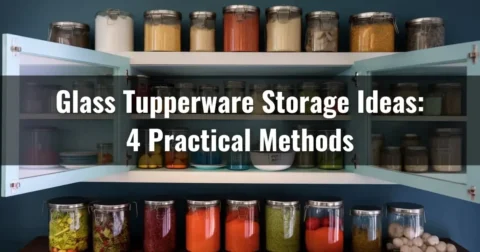Both glass and plastic meal prep containers are best suited for storing carefully prepared meals in the kitchen. As both glass and plastic meal prep containers have their own unique characteristics, you need to determine which container best suits your needs and priorities.
One key distinction lies between the chemical safety of glass and plastic containers. Glass, renowned for its chemical inertness, does not release harmful chemicals even when exposed to heat or acidic foods.
In contrast, some plastic containers, depending on their composition, may contain potentially harmful chemicals such as BPA or phthalates. When exposed to high temperatures, these substances can leach into your food.
We will discuss all the differences between glass and plastic meal prep containers in detail so you can assess which option is right for you.
Jump to Section
7 Differences Between Glass and Plastic Meal Prep Containers
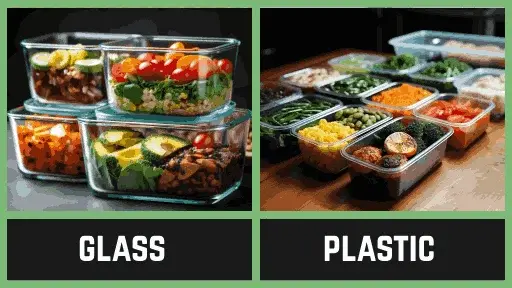
There are a number of distinctions among glass and plastic meal prep containers.
- Chemical safety
- Environmental impact
- Odor and stain resistance
- Weight and portability
- Durability & child-friendliness
- Safety during heating
- Cost and longevity
1. Chemical Safety
Regarding chemical safety, glass containers are the safer option. Glass is a chemically inert material, which means it does not react with food. As a result, it is an excellent choice for meal preparation container storage.
On the other hand, plastic containers contain chemicals such as BPA and phthalates that can leach into food when exposed to high temperatures. These chemicals can harm the human body, particularly if ingested in high quantities.
Research has shown that some of these chemicals can disrupt hormone levels, leading to a range of health problems.
2. Environmental Impact
If you care about the environment, glass containers are the clear winner. That’s because glass is infinitely recyclable. Every time you recycle a glass container, it can be used to make a new one without losing any quality.
This is very different from plastic, where only certain types of plastics can be recycled, and even then, the recycling rate is abysmally low. In fact, only a meager 8% of plastic containers in the U.S. are recycled, leading to serious environmental problems.
Over time, these plastic containers accumulate in landfills and waterways, which can take hundreds of years to break down. As a result, our environment becomes contaminated with microplastics that can harm wildlife and even enter our food chain.
3. Odor and Stain Resistance
Glass containers are made of a non-porous material, which means they do not absorb stains, odors, or food residue. This makes them a great option for meal prep, as you don’t have to worry about your meals leaving behind any unwanted scents or stains.
Conversely, containers made of plastic can pick up the smells and stains of certain foods, which can be difficult to remove over time. This can lead to lingering smells and discoloration, making your meal prep containers look and smell unappealing.
4. Weight and Portability
Regarding weight and portability, plastic containers are the clear winner. They’re lightweight and easy to carry, making them an excellent choice if you’re always on the go. You can easily pack them in your backpack or gym bag without adding too much weight to your load.
In contrast, glass containers are heavier and not as portable. If you commute or travel frequently, then glass containers may not be the best choice for you. They’re more suitable for home meal prep or storing food items in the fridge.
5. Durability & Child-Friendliness
If you have children at home, then their safety is your top priority. Glass containers are fragile and more likely to break if dropped, making them less suitable for households with children.
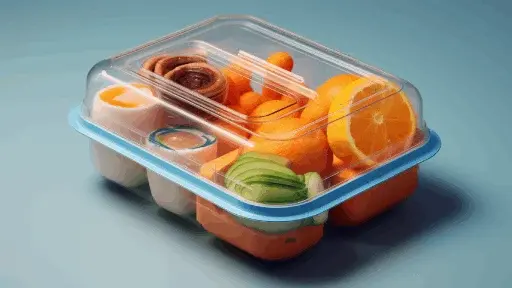
It is safer to use plastic containers if you have small children running around since they are unlikely to break if they are dropped. Plastic containers also come in fun colors and designs that can appeal to children, making them more likely to use them.
6. Safety During Heating
Suppose you plan on reheating your meals or using your containers for cooking. In that case, safety during heating is a crucial factor.
Glass containers are generally considered safe for heating in the oven or microwave. Still, you need to take precautions to prevent thermal shock, which can cause them to break.
Meanwhile, certain plastic containers may not be safe for heating, as they can release harmful chemicals when exposed to high temperatures.
7. Cost and Longevity
Glass containers tend to be more expensive than plastic containers in the short term but are a much better investment in the long run. They are made of thick, durable glass that can resist cracking, chipping, and scratches, meaning that they are less likely to break and require replacement.
In contrast, plastic containers offer a cheaper option for those on a tight budget. They are less costly upfront, but the quality of the plastic can be questionable. Their short-lived nature will result in you buying more sets in the long run, which can be costly.
Glass or Plastic Meal Prep Containers: Which Option Should You Select?
When deciding between glass and plastic meal prep containers, consider which option best suits your needs and priorities.
If you prioritize environmental sustainability, food safety, and long-term durability, glass containers are the way to go. They’re eco-friendly, resist stains and odors, and don’t leach harmful chemicals into your food. Glass containers are ideal for reheating and freezer storage.
On the other hand, if convenience, portability, and affordability are your main concerns, plastic containers might be more suitable. They’re lightweight, won’t shatter if dropped, and can be practical for on-the-go meals.
However, we suggest opting for glass containers, especially if health concerns are a priority for you. Glass containers offer a safer and more eco-friendly choice, ensuring the safety of your stored meals.
How to Ensure Safety for Storing Meals in Plastic Containers?
If you really intend to store your meals in a plastic container, you should know a few things to do so safely.
1. Choose Food-Grade Plastic
To ensure the safety of your meals, you should be sure to only use plastic containers that are marked “food-grade.” These containers are specifically designed for storing food and are less likely to contain harmful chemicals.
Food-grade plastic is made with materials that are approved by regulatory agencies such as the FDA, which means they undergo rigorous testing and are safe for food contact.
2. Resin Identification Codes (RIC)
Another way to store meals safely in plastic containers is to pay attention to the Resin Identification Codes (RIC) on the containers. These codes can provide valuable information about the materials used to make the plastic container.
Codes 1, 2, 4, and 5 are considered safer for food use, while codes 3, 6, and 7 may contain less safe materials. It’s essential to be mindful of these codes when selecting plastic containers for food storage.
3. Avoid BPA and Phthalates
Opting for plastic containers labeled as “BPA-free” is another way to ensure safety when storing meals in plastic containers. BPA is a potentially harmful chemical often found in plastic containers, so looking for containers labeled as “BPA-free” will reduce the risk of exposure to this chemical.
Also, it’s crucial to avoid containers that may contain phthalates, which can also be harmful to your health.
4. Avoid Heating in Plastic
A crucial step in ensuring safety when storing meals in plastic containers is to avoid heating food in plastic containers, especially those not labeled as “microwave safe”.
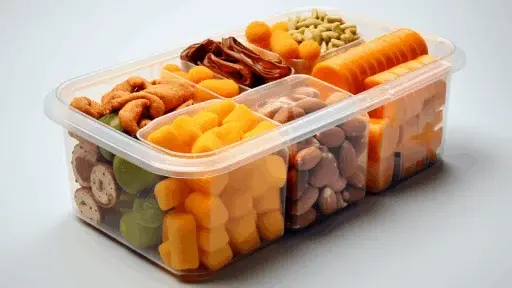
Heating plastic in containers can cause harmful chemicals to leach into your food, posing a risk to your health. Be sure to transfer food to a microwave-safe container before reheating.
5. Avoid Freezing in Plastic
It’s essential to avoid freezing food in plastic containers unless they are specifically designed for freezer use. Freezing can cause plastic to deteriorate and may lead to chemical leaching during defrosting.
To ensure safety, use containers labeled as freezer safe or opt for alternative storage options, such as glass containers or freezer bags.
FAQ’s: Glass vs Plastic Meal Prep Containers
Many homeowners have questions regarding storing glass and plastic meal preparation containers. Here are a few of them that may be helpful to you.
What temperatures can glass and plastic meal prep containers withstand?
Glass meal prep containers can typically withstand ovens up to 425 degrees Fahrenheit, but it’s essential to consult the product’s safety manual or the manufacturer for precise temperature guidelines. However, the lids accompanying these containers are generally unsafe for oven use.
On the other hand, plastic meal prep containers made from materials like polypropylene (PP) and high-density polyethylene (HDPE) have different temperature tolerances.
PP containers can handle temperatures ranging from -4°F to 14°F at the minimum and 212°F to 266°F at the maximum, while HDPE plastics are considered safe for short periods up to 248°F or for long periods up to 230°F. You must be aware of these temperature limits to safely use these containers for your specific meal prep needs.
Are glass meal prep containers dishwasher-safe?
Many glass meal prep containers are indeed dishwasher-safe, making them convenient for both meal preparation and cleaning. They can withstand repeated cycles in the dishwasher without any adverse effects on their durability or appearance.
However, as a best practice, we suggest that you refer to the product’s instructions or labeling for any specific care guidelines or limitations. This ensures that you can maintain their quality and longevity while enjoying the convenience of easy cleaning.
Conclusion
When choosing between glass and plastic meal prep containers for your storage needs, carefully weigh the pros and cons. While plastic containers offer convenience and affordability, they come with potential risks, especially if not handled and carefully selected.
Glass containers, on the other hand, emerge as the safer and more eco-friendly choice, prioritizing your health and the environment. Their chemical safety, environmental impact, and durability make them a top pick for storing your meticulously prepared meals.
So, if health and safety are your priorities, the clear path points to selecting glass containers, ensuring that your stored meals remain as wholesome as the day you made them.


